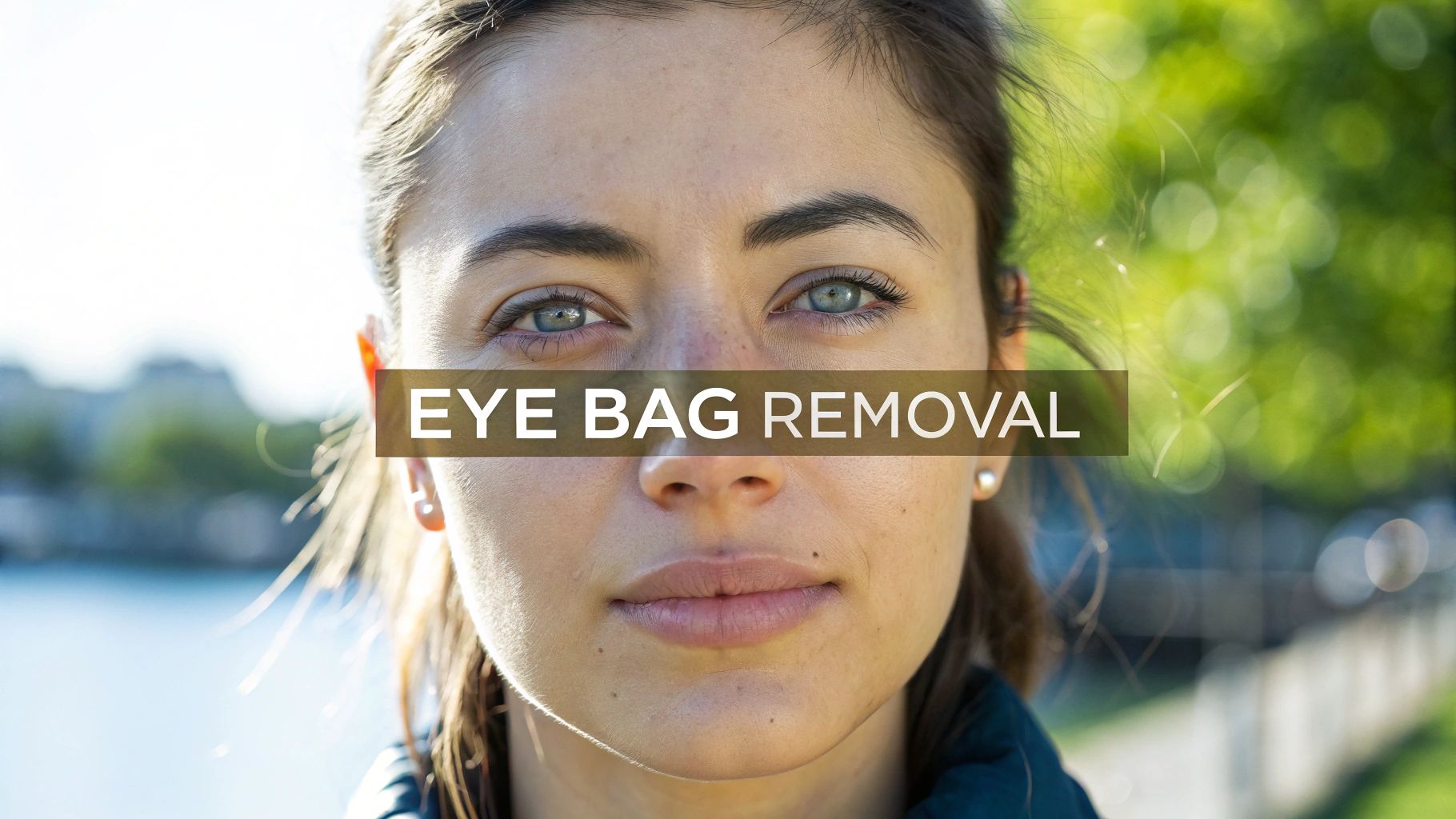.webp)
Eye bag removal tackles the puffiness and swelling that can appear under the eyes, using both surgical and non-surgical methods. These bags often crop up when the tissues around your eyes weaken and the small fat pads that cushion them shift, creating a tired look no matter how much you’ve slept. The right approach to eye bag removal really comes down to what’s causing them in the first place.
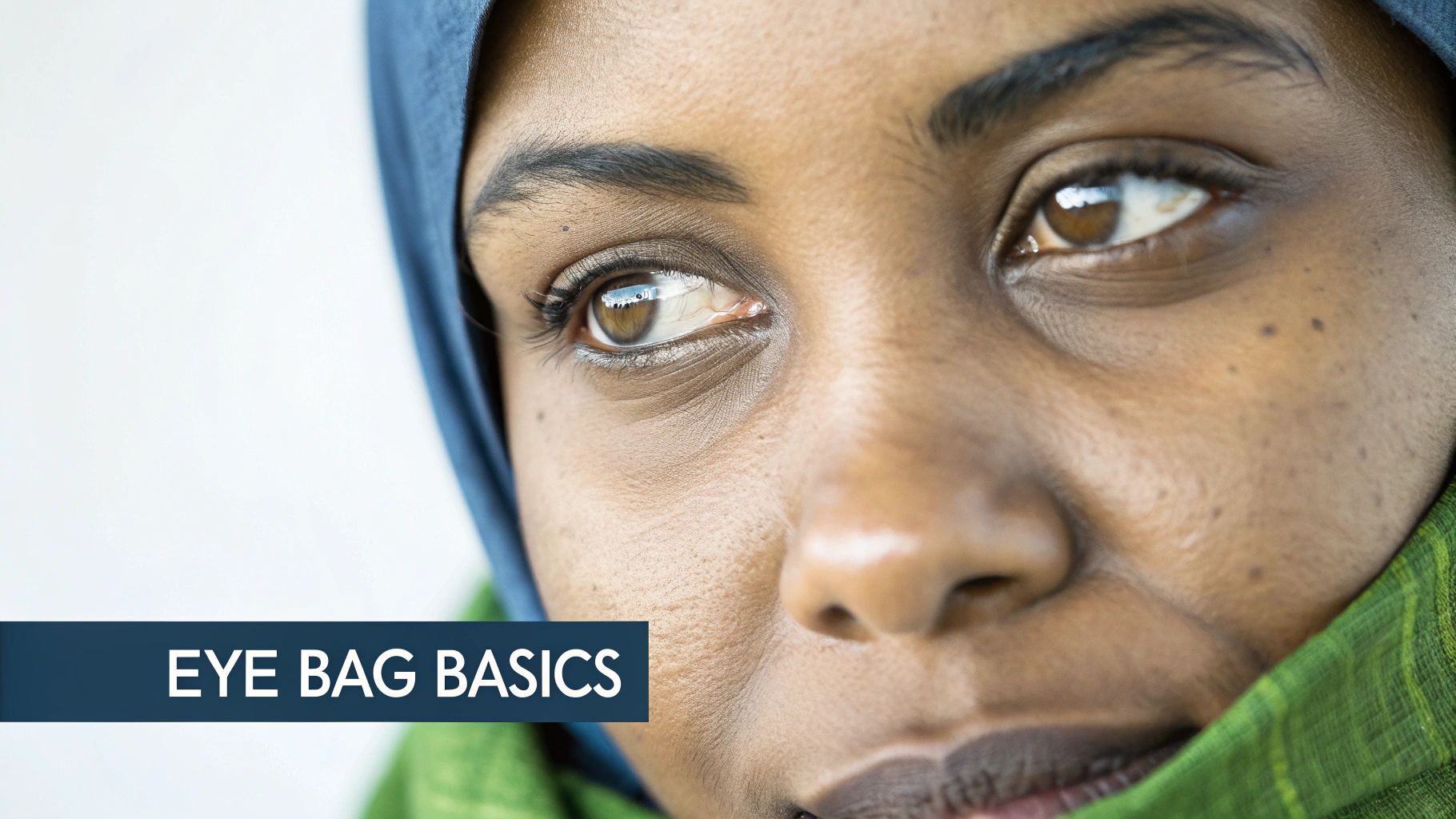
Before we can even think about solutions, we need to get to the root of why under-eye bags form. Imagine the delicate skin and muscle below your eyes are like a supportive hammock. With time, this hammock can start to lose its tautness, allowing the fat and fluid behind it to bulge forward.
This isn’t down to just one thing; it's usually a mix of natural ageing, genetics, and a few lifestyle habits, all working together to create that puffy, tired appearance.
The two main culprits behind stubborn eye bags are nearly always the natural ageing process and your family tree. As we get older, our bodies simply produce less collagen and elastin – the essential proteins that keep our skin firm and springy. The skin under our eyes is already the thinnest on the body, so when it loses this structural support, it becomes lax.
At the same time, the thin membrane that holds back the orbital fat (the cushion for our eyes) also starts to weaken. This lets the fat push forward, creating that noticeable bulge. For many people, it’s just hereditary. If your parents have prominent eye bags, there’s a good chance you will too.
While you can’t turn back the clock or change your genes, some lifestyle choices can definitely make eye bags more obvious. These factors often trigger fluid retention and inflammation, which only worsens any existing structural weakness.
Here are the key lifestyle contributors:
Understanding the root cause is the first step toward effective eye bag removal. Is it sagging skin, a protruding fat pad, or simply fluid retention? Pinpointing the source helps determine whether a surgical procedure, a non-invasive treatment, or a simple lifestyle adjustment is the most appropriate path forward for you.
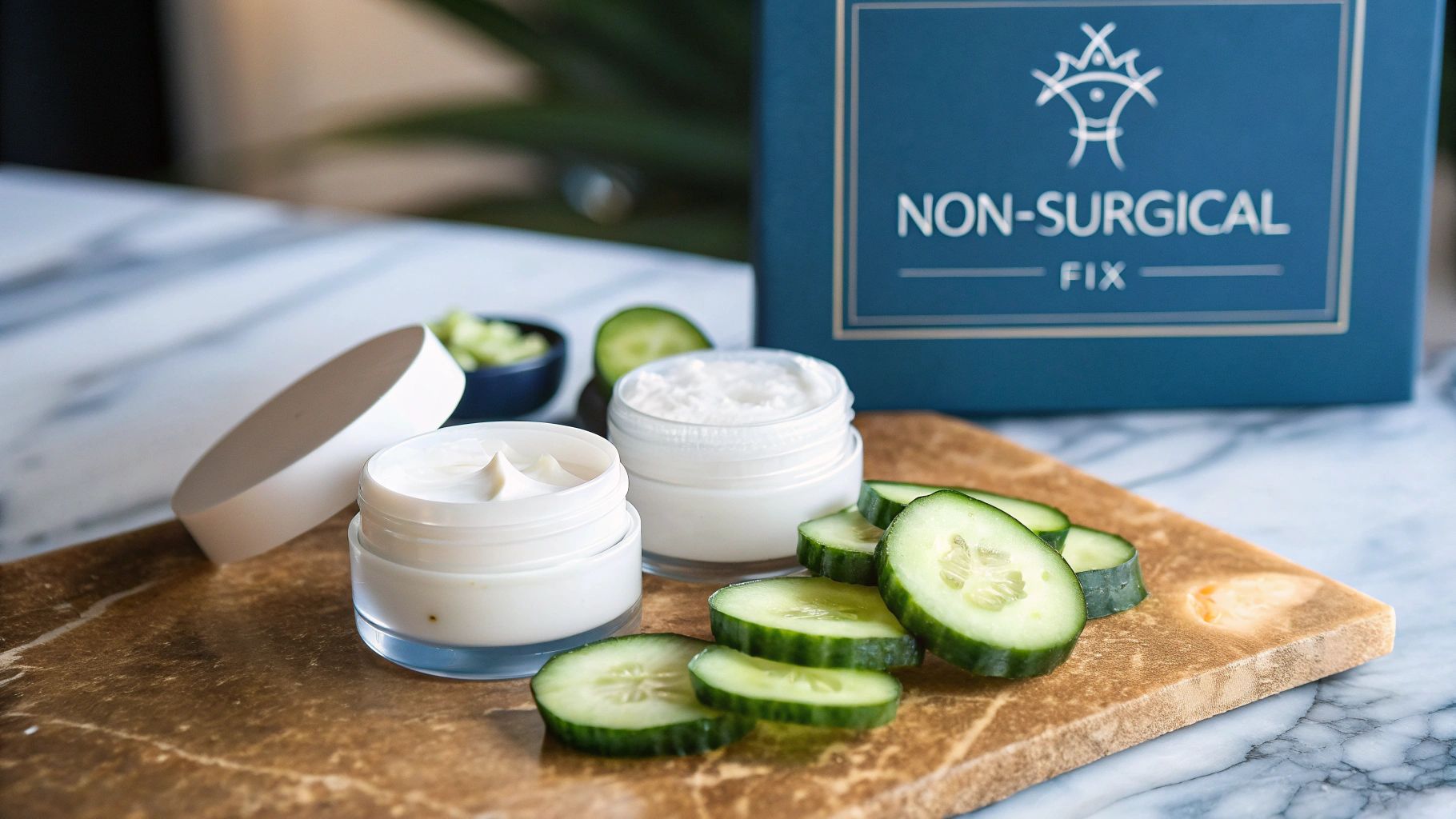
For many of us, the idea of going under the knife for eye bags is a non-starter. The good news is, you don't have to. A whole host of effective non-surgical treatments now exist, offering fantastic improvements with barely any downtime. These procedures are designed to smooth, tighten, and refresh that delicate under-eye area without a single incision.
Think of these treatments as clever tools that work either on the skin's surface or just beneath it. They can fill in hollows that cast shadows or, even better, encourage your skin to rebuild its own support structure from within. This makes them a brilliant choice for anyone with mild to moderate eye bags who just isn't ready for a full surgical commitment.
One of the most popular ways to get an instant fix is with dermal fillers, specifically for the tear trough. This is the little groove that runs from the inner corner of your eye down your cheek. When this area loses volume over time, it creates a hollow that makes eye bags look much more obvious.
Dermal fillers, which are typically made of hyaluronic acid, act like a subtle plumping gel. A skilled practitioner carefully injects the filler into that hollow, which instantly lifts the skin and creates a much smoother transition between your lower eyelid and cheek. The result? The shadow is camouflaged, and the bag looks dramatically reduced. If your main issue is under-eye hollows making bags look worse, a dedicated tear trough treatment could be exactly what you need.
The results are immediate and can last anywhere from 9 to 18 months. Better still, the whole procedure is quick, often done in under 30 minutes with very little discomfort.
Who is it for?The ideal person for fillers has good skin elasticity and a clear hollow under the eye. If you have very thin skin or a significant fat bulge, fillers might not be the best fit, as they can sometimes make puffiness look worse.
Beyond fillers, some of the most exciting advancements are in technologies that improve the skin itself. These treatments use different forms of energy to kick-start your body’s natural healing processes, tightening the skin and rebuilding lost collagen for a firmer, more youthful look. It's a more gradual approach, but the results can be fantastic.
Two of the leading methods here are laser resurfacing and radiofrequency (RF) treatments.
Another game-changing approach uses your body's own healing power. Platelet-Rich Plasma (PRP) therapy is a regenerative treatment that harnesses growth factors from your own blood to rejuvenate the under-eye skin from within. You can learn more about how to explore PRP therapy with us for a completely natural improvement.
When creams and temporary fixes just aren’t cutting it, surgery offers a more lasting and powerful solution for under-eye bags. Clinically, this is called a lower blepharoplasty, and it’s really the gold standard for dealing with stubborn bags caused by displaced fat or loose skin. It’s a precise operation designed to smooth out the under-eye area and bring back a more youthful contour.
The real artistry here isn’t just about removing tissue. Think of it like a lumpy cushion; you wouldn't just tear out random handfuls of stuffing. A skilled surgeon carefully redistributes the filling and trims the excess fabric to restore a smooth, natural shape. That’s exactly the goal with a blepharoplasty—to create a refreshed look, not an 'overdone' one.
Surgeons generally take one of two routes for a lower blepharoplasty. The right one for you comes down to your unique facial structure and the specific cause of your eye bags. Both are incredibly effective, but they differ in where the incision is made.
In the hands of an expert, the scar from this approach heals beautifully, tucked away in a natural crease until it’s virtually invisible. The image below shows what typically leads people to consider surgery in the first place.
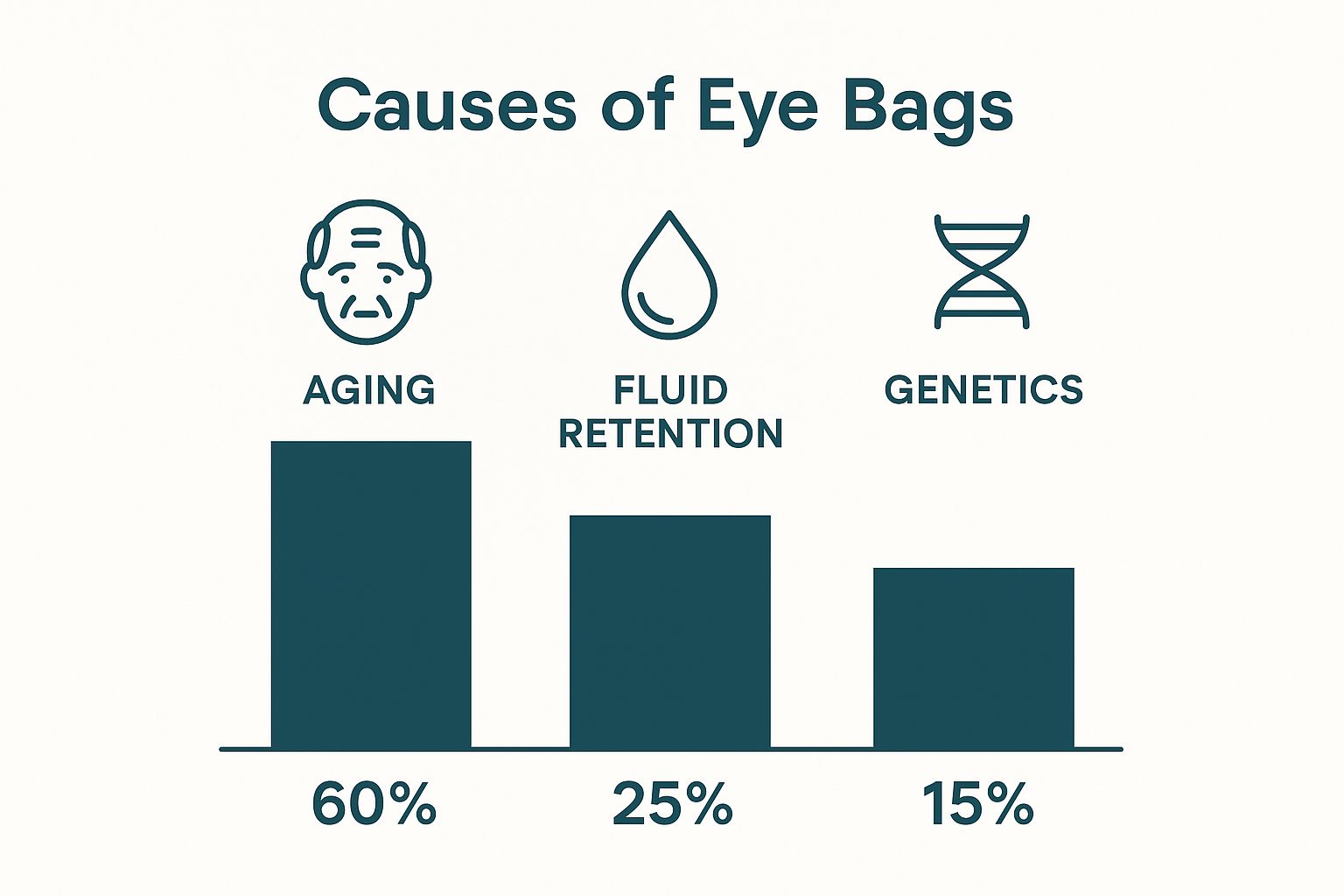
As you can see, the natural ageing process is by far the biggest driver, but genetics and fluid retention are also common culprits behind under-eye bags.
Your journey will start with a detailed consultation. This is where your surgeon gets to know you, assesses your facial anatomy, and talks through your goals. They’ll also check your medical history to make sure you’re a good candidate for the procedure. It’s the perfect time to ask all your questions and get a really clear picture of what to expect.
Eyelid surgery has seen a huge surge in popularity recently, which speaks volumes about its effectiveness. In fact, there was a massive 70% increase in these procedures in 2022. This spike brought the total number for women in the UK to nearly 20,000 for the year, showing just how much trust people are placing in the results.
On the day itself, the surgery is usually performed under local anaesthetic with sedation, though general anaesthesia is also an option. It typically takes about one to two hours. You’ll be able to head home the same day, but you will need someone to drive you.
Opting for surgery is a big decision, and the result is almost entirely down to the skill of the person holding the scalpel. It is absolutely vital that you choose a board-certified plastic surgeon who has deep experience in facial procedures. Knowing how to choose a plastic surgeon is the first and most critical step you can take for your safety and satisfaction.
A great surgeon brings more than just technical ability; they have an artist's eye for creating natural-looking results that complement your entire face. They’ll be with you every step of the way, from that first chat to your final check-up.
For anyone looking for that level of expert care, you can learn more about our dedicated plastic surgery specialty here. This is about ensuring you feel confident and safe on your journey to brighter, refreshed eyes.
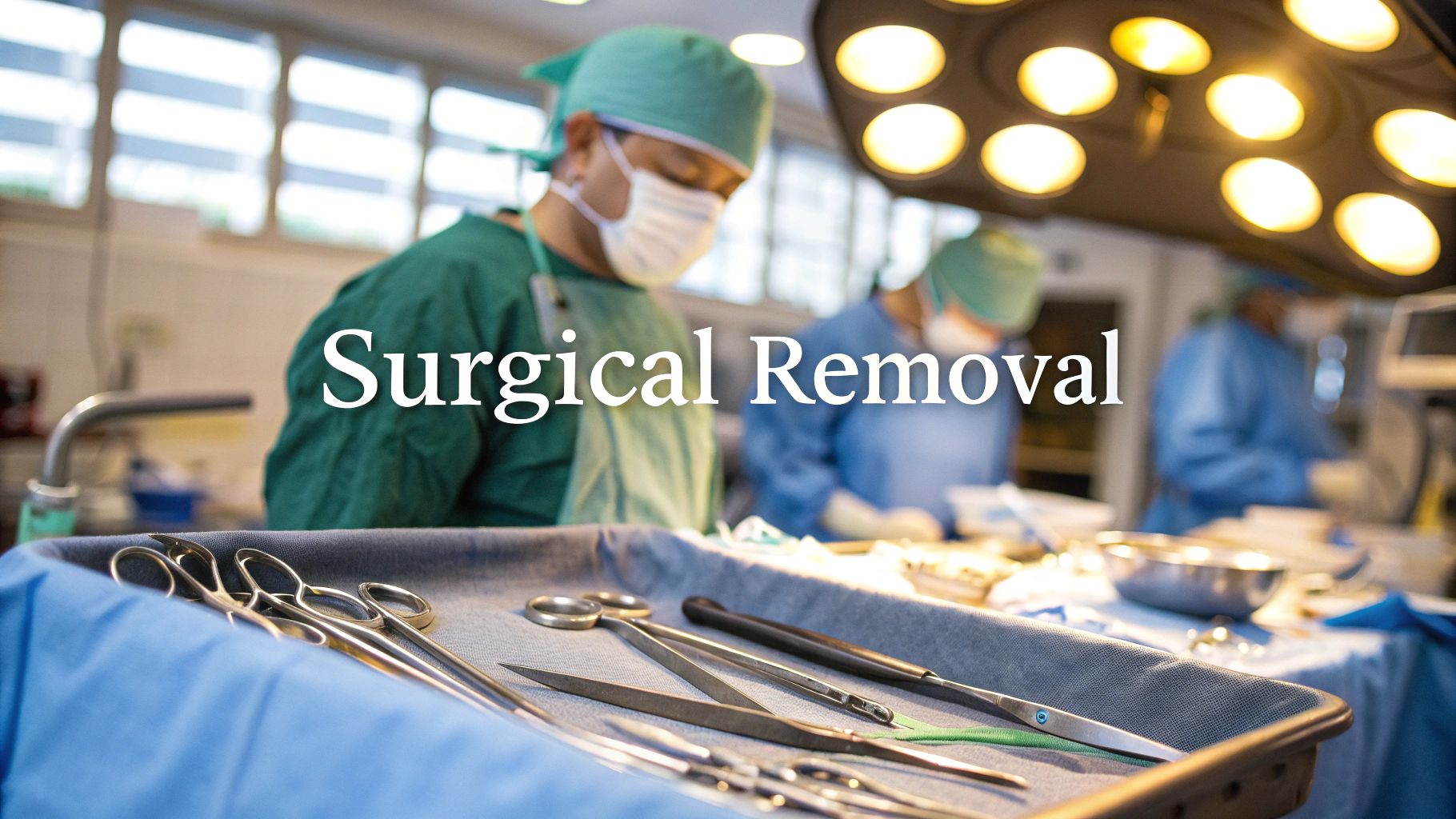
The success of your eye bag removal journey doesn’t end when you leave the operating theatre. A smooth, successful recovery is every bit as vital as the surgery itself, and knowing what’s coming can make the whole process feel far less daunting.
Think of it as a structured healing phase. Your body just needs a bit of time, care, and rest to let the final, refreshed results shine through. While everyone’s experience is unique, the recovery timeline is fairly predictable. The first few days are all about managing swelling, while the following weeks focus on gradually getting back to your normal routine.
Getting prepared beforehand makes a huge difference. Taking some time to understand how to prepare for surgery can arm you with the knowledge you need for a calm, organised recovery.
That first week is the most intensive part of your recovery, and your main job is simply to rest. It's completely normal for your eyes to feel a bit tender, and you'll definitely notice some swelling and bruising around the area. This is just your body’s natural response to the procedure.
Your surgeon will give you a list of very specific instructions to follow. Think of these as your essential toolkit for a comfortable recovery. They’ll likely include:
By the end of the first week, usually around day five to seven, you'll have a follow-up appointment to have any stitches removed. Most people find that the bruising and swelling have already peaked and are now starting to go down.
As you head into the second week, you’ll start to look and feel much more like yourself again. The most obvious bruising and swelling will have faded, although a little bit of puffiness might hang around for a bit longer. Most people feel comfortable enough to get back to work and social activities around 10 to 14 days after their surgery.
During this time, you can gradually reintroduce light activities. Gentle walks are perfectly fine, but you should continue to steer clear of high-impact exercise and heavy lifting for at least another three to four weeks. It’s also important to protect your eyes from the sun and wind, so a good pair of sunglasses is a must when you’re heading outdoors.
You’ll see a big improvement within the first couple of weeks, but the final, polished outcome of your surgery takes a little time to emerge. The tissues need to settle completely, and all that minor, lingering swelling needs to disappear.
Patience is key here. Most patients see their final, optimal results within three to six months after the procedure. At this point, the under-eye area will look smoother, firmer, and more naturally rested, revealing the full benefit of your surgery. Following your surgeon's aftercare advice diligently is the single best way to ensure you achieve the beautiful, long-lasting results you’re hoping for.
Deciding on any cosmetic procedure, especially one for your face, means taking a clear-eyed look at both the rewards and the realities. Choosing eye bag removal isn't just about a physical change; it's often a deeply personal step towards aligning how you look with how you feel inside. Weighing up what you can gain against the potential downsides is the most important part of making a confident, informed decision.
The benefits often reach far beyond the mirror. Many people tell us they feel a huge boost in self-confidence afterwards. By smoothing out the under-eye area, the procedure can give you back a more rested and vibrant appearance, helping you look as energetic as you feel. It’s not about becoming a different person, but a refreshed, more authentic version of yourself.
The main goal of eye bag removal is to create a smoother, more natural transition between the lower eyelid and the cheek. This one change can have a ripple effect on your whole appearance.
The popularity of these procedures in the UK really speaks for itself. It's thought that eyelid surgeries could make up 15-20% of all facial cosmetic procedures by 2025. This is part of a bigger picture, with a predicted 1.2 million blepharoplasty surgeries happening worldwide. The UK plays a huge role in this market, which is valued at £2.4 billion. You can dig deeper into these trends in this detailed 2025 cosmetic surgery report.
While eye bag removal surgery is overwhelmingly safe and successful, no procedure is completely without risk. Knowing about potential complications is key to a smooth journey. Thankfully, these issues are rare, especially when you’re in the hands of an experienced, board-certified surgeon.
Potential risks can include:
It’s vital to understand that choosing a highly qualified surgeon is the single most effective way to minimise these risks. Their expertise ensures precise technique and proper care before and after your procedure, safeguarding your health and your results.
Finally, a successful outcome always comes down to realistic expectations. Eye bag removal can create a fantastic improvement, but it doesn't stop the natural ageing process. While the fat that’s removed won't come back, your skin will, of course, continue to age over time.
Think of it as resetting the clock, not stopping it altogether. The goal is a natural, rejuvenated look that works in harmony with your own facial structure. A good surgeon will aim for improvement, not perfection, making sure your results look authentic and balanced. This mindset is the foundation for being truly happy with your procedure.
Stepping into the world of aesthetic treatments can feel a bit daunting. When it comes to something as personal as the area around your eyes, it’s completely natural to have a list of questions. From costs and scars to how long the results will last, getting clear answers is the first step towards feeling confident in your decision.
Here, we’ll tackle the most common questions we hear about eye bag removal in the UK, offering straightforward, practical information to demystify the entire process.
This is often the first question on everyone's mind, and the answer really depends on whether you go down the surgical or non-surgical route. There’s no single price tag; the final cost reflects the treatment's complexity and the practitioner's expertise.
Here’s a general guide to what you can expect:
A surgical quote should cover everything—the surgeon's fee, the anaesthetist, and the hospital or clinic costs. Always make sure you get a detailed, all-inclusive quote during your consultation to avoid any surprises down the line.
The thought of a scar, especially on your face, is a totally valid concern. Thankfully, modern surgical techniques are all about subtlety. Surgeons aim to make incisions virtually invisible once they’ve healed.
There are two main ways they achieve this:
Your surgeon will determine the best approach for you and give you detailed aftercare advice to help everything heal perfectly.
The longevity of your results is another key factor, and there’s a big difference between surgical and non-surgical treatments.
A surgical blepharoplasty is considered a permanent fix. The fat pads that are removed or shifted during the procedure don’t grow back. But it’s important to remember that surgery doesn’t stop the clock on ageing—your skin and facial structures will naturally continue to change over time.
Non-surgical treatments, like fillers, are temporary. The hyaluronic acid is safely and gradually absorbed by your body over time. Results from fillers typically last anywhere from 9 to 18 months, after which you’d need a top-up treatment to maintain the look.
Not everyone is the right fit for eye bag removal, which is why a thorough consultation is so important. Generally, the best candidates are healthy people who are bothered by persistent under-eye bags caused by structural issues—like protruding fat or significant skin laxity—rather than temporary puffiness from allergies or a bad night's sleep.
It’s also crucial to have realistic expectations. The goal is improvement and a more refreshed appearance, not chasing an unachievable ideal of perfection.
Ultimately, the only way to know for sure is to speak with a qualified expert. They can assess your individual situation and recommend the most effective path forward. Looking through our diverse range of services can give you an idea of the options available, but a one-on-one consultation is essential to confirm which treatment will get you the results you’re looking for, safely and effectively.
At The Vesey, our team of specialists is here to guide you with expert care and personalised advice. Book a consultation with us today to explore your options and create a treatment plan that helps you look and feel your absolute best.

